|
|
|
Codex Flores 5/2011
Farbige, sinnenverliebte, prahlerische Musik |
|
| Musique de la Grande Écurie & des Gardes Suisses |
|
An der Schola Cantorum Basiliensis widmete man sich der Grande Écurie und den Gardes Suisses am französischen Hof Ludwigs XIV. und XV: Trompettes, Violons, Hautbois, Saqueboutes, Cornets, Musettes du Poitou, Fifres, Tambours, Cromornes und Trompettes marines. Die Namen alleine sind schon Musik. Die Klangerzeuger haben nicht nur abenteuerliche Namen, sie tönen auch so. Da finden sich abenteuerlich anmutende Gebilde wie die Trompettes marines. Es handelt sich dabei nicht etwa um Blechblasinstrumente, wie man zunächst meinen könnte, sondern um Varianten der sogenannten Trumscheite mit länglichem Korpus und Saiten, die gestrichen werden.
Auch die musikalischen Formen, die damit gepflegt wurden, sind alles andere als langweilig: Da gab’s den Combat grotesque und die Maskeraden, teils mit orientalischen Motiven. Natürlich wurden Jagdgesellschaften reichlich mit Musik versorgt. Und es gab sogar veritable Grossstadt-Musik – le grand bruit – die das Treiben und Lärmen in Paris nachahmte. Die farbige, sinnenverliebte, prahlerische Musik, die der Hof sich sicherlich etwas kosten liess, ist Zeugnis einer Gesellschaft, die sich grenzenlos zu amüsieren wusste.
Die teils masslosen Amüsiergesten werden da auch zu Vanitas-Motiven. Man erinnert sich unvermittelt und mit etwas Schaudern an die skurrile Art, wie Jean-Baptiste Lully, einer der hier prominent vertretenen Hof-Compositeure zu Tode gekommen ist. Adieu, du parfümierte Welt der Reichen und Schönen. |
wb |
|
Glareana 1/2011
Überraschende Klangerlebnisse und mitreissende Musik |
|
| Musique de la Grande Écurie & des Gardes Suisses |
|
Auch in der Szene der Alten Musik kommt es selten vor, dass man wirklich "neue" Klänge zu hören bekommt. Auf der hier besprochenen CD ist dies der Fall! Sie führt uns an einen - zumindest musikalisch - bisher wenig beachteten Ort des Französischen Hofs: die Grande Écurie (den Grossen Marstall), eine wichtige Abteilung der Hofhaltung, in der die Dressur-, Kriegs-, Reit- und Jagdpferde des Hofes untergebracht waren, an der aber auch musikalisches Personal tätig war. In einem mehrjährigen Forschungsprojekt des SNF hat die Schola Cantorum Basiliensis vor allem die mysteriösen Gruppierungen „Cromornes et Trompettes marines“ sowie „Fifres et Tambours“ untersucht. Als Ergebnis entstanden nachbauten von Instrumenten, wie sie bisher noch nicht bekannt waren, so ein Ensemble von Doppelrohrblattinstrumenten - eben die „Cromornes“ -, noch vor der definitiven Ausprägung der „barocken“ Oboen, Fifres (Querpfeifen militärischer Tradition), die in dieser Art ebenfalls noch nicht rekonstruiert wurden und Tambours, die in ihrer Grösse und Machart Neuland bedeuteten. Fifre und Tambours wurden auch von der Leibgarde des Königs benutzt, den „Cent Suisses“ sowie von den militärischen Gardes Suisses.
Die rekonstruierten Instrumente werden auf der CD mit bereits zurück eroberten kombiniert (Trompettes marines, Naturtrompeten französischer Prägung) und in einem abwechslungsreichen Programm akustisch vorgestellt. Thilo Hirsch hat hierzu Musik aus der berühmten Sammlung von André Philidor ausgewählt und für die verschiedenen Besetzungen zusammengestellt. Die CD ist ein Fest an unterschiedlichen Klängen und Farben, garniert mit ausführlichen Informationen im Booklet. Unterhaltsam zu hören, mit überraschenden Klangerlebnissen und mitreissender Musik. Für alle, die an historischen Musikinstrumenten interessiert sind, geradezu ein „Muss“. |
td |
|
Basler Zeitung 11/2010
Königliche Klänge |
|
| Musique de la Grande Écurie & des Gardes Suisses |
|
Die Monarchie ist tote Geschichte, aber Musik der französischen Königshöfe aus dem Barockzeitalter überlebt. Auch dank der Forschungsarbeit an der Basler Schola Cantorum, die jetzt zu dieser schönen Kompilation von Musik für die "Grande Ecurie" geführt hat. Zu klären war dabei zuerst die Frage nach dem Instrumentarium. Wird dieses so beherzt und sensibel eingesetzt wie vom Ensemble Arcimboldo in den von Thilo Hirsch geleiteten Aufnahmen, ist die Musik eine prickelnde Freude - trotz dem Blutgeruch der Monarchie, der an ihr klebt. |
bli |
|
www.classicalcdreview 01/2008
Excellent performance |
|
| J.V. Rathgeber - "Messe von Muri", Concertos |
|
|
Johann Valentin Rathgeber (1682-1750) composed his Messe von Muri in 1731 and the score presumably was lost until Thilo Hirsch, who conducts this performance, was able to reconstruct it from various sources. Hirsch also provided detailed information about instrumentation of all of the works on this disk stating that one of the concertos is the first known clarinet concerto and the Telonius concerto is the first of a concerto for "trumpet marine." Performances throughout are excellent and the recording, made in Abbey Church of Muri in October 2006, is appropriately spacious and resonant. |
R.E.B |
| |
www.new-classics.co.uk 03/2008
Highly recommended |
|
| J.V. Rathgeber - "Messe von Muri", Concertos |
|
|
The present recording restores the music to its place of origin as it was recorded in the beautiful abbey church of Muri, with its outstanding acoustics and splendid baroque architecture. The original sound of the composition and the interpretation with baroque instruments meet and form a unique whole. To complement the existing instruments from the baroque era, a number of replica historical instruments were reconstructed, including the trumpet marine, a monochord string instrument ingeniously designed to sound like a trumpet, and the chordophone drum whose sound is produced by striking a single string. Solo concertos taken from Johann Valentin Rathgeber’s ‘Chelys sonora’ and recorded here as well present other historical instruments (baroque violin, baroque trumpet and baroque clarinet). The trumpet marine is also represented in a solo concerto by Rathgeber’s contemporary, Christian Gottfried Telonius. The music is performed in energetic and authentic style by the excellent ensemble Arcimboldo, directed by Thilo Hirsch. The SACD sound quality is outstanding and this unique release is highly recommended. |
John Pitt |
|
Nürnberger
Nachrichten 10/2004
Brassy
sound gems from Swiss monasteries
|
|
|
The ensemble arcimboldo presented the „Trumpet
marine" at the Germanic National Museum in Nürnberg.
|
|
|
The enthusiastic audience quickly grasped why the
trumpet marine, an instrument that was widely used during
the 17th and 18th centuries, was also referred to as the
„trumpet of the nuns" or the „trumpet
violin": When Thilo Hirsch, the founder of the
ensemble, and Michael Bürgin produced remarkably
trumpet-like overtones on their large, boxy string
instruments by using flageolet technique and a vibration
bridge it was hard to imagine how the music (brought to
the concert stage by Hirsch after having discovered the
scores in several Swiss monasteries) ought to have sounded
any different : the sound of the trumpet marine harmonised
so organically with the rest of the ensemble.
It was an unusual déjà vu experience: This is
the very first time that all of us heard these instruments
being played, but the sound was absolutely convincing and
strangely familiar. The trumpet marine even has several
advantages over the "regular" trumpet: it has a
less piercing sound and the remarkable capacity to create
the impression of an entire group of trumpets playing very
discreetly. Thereby the trumpet marine adapted
astonishingly well to the refined and dynamically nuanced
sound of the complete ensemble with its organ, voices,
strings, and baroque bassoon.
Sara Bilén (Soprano), Monika Barmettler (Alto), Dieter
Wagner (Tenor) und Raitis Grigalis (Bass), all were
well-seasoned performers – not just "inter choros
angelorum". With the „Travel to Ettingen" the
ensemble went into chromatic high gear. Suddenly it became
clear that composer Michael Bürgin had smuggled his
cantata, enhanced with jazzy bass riffs, delightful
pizzicato effects, and Orff-like might, into the evening’s
precious program of historical sacral works.
Will the trumpet marine become a new gadget on the
contemporary music playground ? Why not ! – in any
event, there have rarely been that many overtones….. |
|
Anja
Barckhausen
|
|
Basellandschaftliche
Zeitung 10/2003
It sounds like a trumpet |
|
|
" ...the ensemble arcimboldo presented music for
trumpet marine from the middle of the 18th century to a
raving audience. Already with the Offertorium
"Gaude Felix" the joy of music contagiously
spread from the performers to the listeners who entered an
unknown old world of music. The 2 trumpet marines were
recently constructed copies of original instruments. Their
sound, when played by Thilo Hirsch and Michael Bürgin,
had the brilliance of trumpets, which was a fascinating
experience that lasted for the entire concert: a string
instrument with a brassy sound.
Michael Bürgin was not only musician, but also the
composer of the piece "Travel to Ettingen" for 4 voices, strings, bassoon, 2 trumpet marines,
and orgal: a light-hearted, exciting masterpiece, the
world premiere of which was given during this concert
series.
The performance of the ensemble arcimboldo was superb
and Agnieszka Kowalczyk (Soprano), Monika Barmettler
(Alto), Raphaël Favre (Tenor) und Peter Zimpel (Bass)
made for a well-balanced quartet of soloists. The soprano
excelled with her angel-like clarity, wonderfully
versatile voice, and unostentatious sound. Baroque
connoisseurs who have praise for Emma Kirkby should look
out for Kowalczyk. |
|
Barbara Nüesch
|
|
Schwetzinger
Woche 09/2004
Der
Meerestrompettist
|
|
|
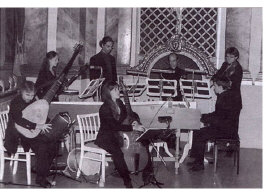 [.....]
The dance group (Barbara Leitherer, Irene Pedrotti,
Dietmar Vonwiller and, in particular, Bernd Niedecken),
stylistically hit a golden, Baroque home run. […..] The
Baroque orchestra played music that complemented the
action on stage, composed by Marais, Lully, Prin, Rameau
and Forqueray. The musicians were superb, and were able to
display their incisive qualities and clear sound in a wide
range of situations: in lyrical soloist passages and
classical dance pieces of the time, and also in full
dynamic orchestral interventions "with trumpets and
drums" and the dramatic concluding dance of the
African slaves. The marvellous costumes were made by
Gigliola Vinci und Clara Sarti (La Scala/Milan) […..].
Overall, it was a precious jewel of a performance which
the audience acknowledged with a hurricane of long lasting
applause. [.....]
The dance group (Barbara Leitherer, Irene Pedrotti,
Dietmar Vonwiller and, in particular, Bernd Niedecken),
stylistically hit a golden, Baroque home run. […..] The
Baroque orchestra played music that complemented the
action on stage, composed by Marais, Lully, Prin, Rameau
and Forqueray. The musicians were superb, and were able to
display their incisive qualities and clear sound in a wide
range of situations: in lyrical soloist passages and
classical dance pieces of the time, and also in full
dynamic orchestral interventions "with trumpets and
drums" and the dramatic concluding dance of the
African slaves. The marvellous costumes were made by
Gigliola Vinci und Clara Sarti (La Scala/Milan) […..].
Overall, it was a precious jewel of a performance which
the audience acknowledged with a hurricane of long lasting
applause.
|
|
kob. |
|
Fränkischer
Tag 09/2004
Baroque
Dance Art |
|
TEATRO ARCIMBOLDO from
Basel at the Schwetzinger Rokokotheater |
|
|
"TEATRO
ARCIMBOLDO" is a traveling theater, which for years
now has been been performing at nothing but the most
beautiful historic theaters of Germany. […..].
Thilo
Hirsch, the group’s director and tromba marina player,
never misses an opportunity to give the evening the flavor
of a comedy, but always managing a convincing balance
between historical fact and entertainment. The dancing
king: unbelievably beautiful costume and choreography
(Barbara Leitherer, dance teacher at the Schola
Cantorum)[.....]. Special word of praise for the
imaginative and ever changing costumes, but particular
praise for a fantastic ensemble of musicians who played
historic percussion instruments, violins, bassoon,
harpsichord, theorba, viola da gamba, and recorder on a
magnificent level – nothing unusual perhaps for
musicians coming from the capital of old music with its
Schola Cantorum Basiliensis. |
|
W. S. |
|
Schwetzinger
Zeitung 09/2004
Fascinating
Dance Theatre from the Court of Louis XIV, the Sun King |
|
| TEATRO ARCIMBOLDO with
"The Tromba Marina Virtuoso" at the Mozartfest
Schwetzingen |
|
|
Thilo
Hirsch and his TEATRO ARCIMBOLDO performed the most
exquisite Baroque dance theater last week at the
Rokokotheater Schwetzingen (Hirsch is the founder of the
group, 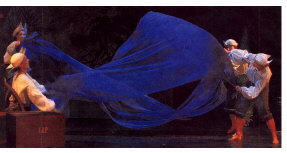 and appeared in the title role of Jean-Baptiste
Prin) […..]. Under the imaginative direction of Hirsch,
the tragicomic story of the only known trumpet marine
virtuoso J.-B. Prin (1668-1743) is presented […..].
Hirsch’s acting was superb as he explained the
construction and sound of the trumpet marine. The
characteristic feature of the tromba marina (played in
masterly fashion by Hirsch) are the resonance strings at
the inside of the instrument’s body. […..] Smooth
performances of Harlequin, Harlequina and Pantalone in a
Commedia dell’Arte Scene. The story gained intensity in
a gloomy prison scene danced by torturers and Zanni in the
Bastille. After Prin’s forced exile in the West Indies,
one of the evening’s dancing highlights was the scene on
the ship –the successful struggle of the sailors with
the wild storm was shown with acrobatic jumps and artful
pantomime. At the end of his trip, Prin arrives in the
jungle where he meets African slaves and identifies in
their "Ungurungu" the origins of the trumpet
marine. The evening convincingly ends with a dance
dialogue between the cultures (music: J.Ph. Rameau). With
inventive choreography, props, and imaginative costumes,
Teatro Arcimboldo took the audience along on a journey to
bygone times. An unforgettable tribute to the tromba
marina. and appeared in the title role of Jean-Baptiste
Prin) […..]. Under the imaginative direction of Hirsch,
the tragicomic story of the only known trumpet marine
virtuoso J.-B. Prin (1668-1743) is presented […..].
Hirsch’s acting was superb as he explained the
construction and sound of the trumpet marine. The
characteristic feature of the tromba marina (played in
masterly fashion by Hirsch) are the resonance strings at
the inside of the instrument’s body. […..] Smooth
performances of Harlequin, Harlequina and Pantalone in a
Commedia dell’Arte Scene. The story gained intensity in
a gloomy prison scene danced by torturers and Zanni in the
Bastille. After Prin’s forced exile in the West Indies,
one of the evening’s dancing highlights was the scene on
the ship –the successful struggle of the sailors with
the wild storm was shown with acrobatic jumps and artful
pantomime. At the end of his trip, Prin arrives in the
jungle where he meets African slaves and identifies in
their "Ungurungu" the origins of the trumpet
marine. The evening convincingly ends with a dance
dialogue between the cultures (music: J.Ph. Rameau). With
inventive choreography, props, and imaginative costumes,
Teatro Arcimboldo took the audience along on a journey to
bygone times. An unforgettable tribute to the tromba
marina. |
|
Basler
Zeitung 08/2004
Baroque
Rapture |
|
| Delightful:
The Dance Theatre Production „The Trumpet Marine
Virtuoso" by TEATRO ARCIMBOLDO (Basel) |
|
|
TEATRO
ARCIMBOLDO presented the busy life of a baroque musician:
Jean-Baptiste Prin (1669-1743) was promoted by his father
to become the only known virtuoso on the "Trompette
marine", this curious string instrument whose sound
is produced using flageolet technique on a single long
string that runs over a vibration bridge – a sound
resembling that of a muted trumpet. Prin’s playing on
this instrument appears to have been so masterful that his
career took him all the way to the court of the sun god
Louis XIV. However, after years of slander and defamation
Prin was forced into exile in Mexico. |
|
The flavor of a comedy |
|
For years,
TEATRO ARCIMBOLDO (directed by Thilo Hirsch) has been a
master of its trade in reviving ancient musical times with
sensuous and colorful productions. Their latest piece once
again is delightful musical theatre. No doubt, the
educational aspects of the production were intentional,
but these were neatly woven into the skilfully constructed
monologue (screenplay: Christopher Zimmer and Thilo
Hirsch). When we were given a stilted courtly introduction
to the complexities of the art of Baroque dance; when the
panic-stricken Prin, fearing punishment and torture,
recites the whole store of knowledge of the time; or when
we were explained various baroque torture methods or the
political situation in Mexico - the flavor always remained
that of a comedy, cleverly connecting the individual
scenes.
Even the
somewhat risky final scene was convincing: Here Prin’s
encounter with dancing African slaves is presented as the
birth of multiculturalism.
Of course,
as in any baroque music theatre there was the inevitable
storm scene, an idyllic moon-and-stars ballet, a wonderful
"theatre within the theatre" scene of a commedia
dell’arte rehearsal (the performance of which brings out
the opposite of the result intended by the jealous
director), and even a magnificent courtly dance by the
sungod himself, ritualised all the way to the trembling of
the fingers. The performance of the dancers was elegant,
strong, and deeply touching to the present-day audience. |
| Dramatic
Music
|
|
In
addition to a "Concert pour la Trompette
marine" by Prin himself, music by the Baroque masters
was played, including Lully, Marais, Forqueray, and of
course Jean-Philippe Rameau. A perfect match in this
setting, Rameau’s music is always dramatic, and carried
the musicians and, thereby, the audience to a state of
Baroque rapture. |
|
David Wohnlich |
|
Orpheus
Oper International 11/2003
Gotha/Ekhof
Festival – A Win with Telemann |
|
|
... Completely satisfying was the performance of
"Don Quixote." The young Baroque theater
ensemble TEATRO ARCIMBOLDO from Basel created an
imaginative, colorful stage spectacle. Telemann’s opera,
supplemented by several dances, was scenically so
imaginatively and lovingly presented that it was a joy to
behold. Musically, too, the performance was a delight. All
the participants, some of them singing and dancing several
roles, performed under the direction of Thilo Hirsch with
perceptible vitality and a joy that was infectious. |
|
Karin Coper |
|
Sonntag-Aktuell
(Ulm) 09/2001
Magical playing and dancing, sonorous singing,
historical instruments, splendid Baroque costumes: |
|
|
...With the seldom-performed "comic chamber-ballet
opera" by G. Ph. Telemann, the ensemble TEATRO
ARCIMBOLDO from Basel provided a magical, much-applauded
finale to the Sebastian Sailer Days. In the sold-out
Mirror Hall of Obermarchtal Monastery, they offered a real
eye catcher and plenty of Baroque.... Specialists in
Baroque and Renaissance music, it is hardly surprising
that with their splendid voices and pantomimic, theatrical
pizzazz the members of the ensemble were able to find
exactly the right approach for Telemann’s music.
Tumultuous applause. |
|
Christa Kanand |
|
Basler Zeitung 08/2001
A huge crowd on the weekend at the premiere of
the comic chamber-ballet opera "Don Quixote, the
Knight of the Lion" by Georg Ph. Telemann in the
English Department of the University. |
|
|
...The chamber-music, dance-theater ensemble
"TEATRO ARCIMBOLDO" carried the festive audience
away to a baroque world full of adventure and beset with
mental torments. To come right to the point: A marvelous
production by Thilo Hirsch, full of magic, grace, and
humor. A charming, imaginative, witty summer delight. |
|
Christa Mosimann |
|
Basler
Zeitung 10/1998
Amorous Dance
Entanglements |
|
|
If music be the food of love, then "TEATRO
ARCIMBOLDO," a Baroque chamber-music/ dance-theater
ensemble, had the right recipe on Friday evening to whet
the audience's appetite. Under the title "If music be
the food of love" or "Amorous Delight and Viol
Tricks", the Baroque piece presented on the stage of
the Marionette Theater on Münsterplatz dove into the
magic of the golden age between the Renaissance and the
Classical period. Where marionettes usually spin their
threads, historically costumed actor-musicians revealed
the broad spectrum of all the fine arts with their 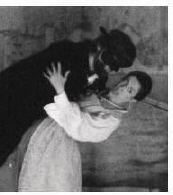 intricate-enchanting
scenes. These were framed by romantic sounds from the pen
of Henry Purcell through Claudio Monteverdi to the highly
ornamented compositions of Michel Pignolet de Monteclair.
What visibly opened the hearts of the audience, and came
to their ears in pure, clearly defined intonation, and
polished vocal refinements, overcame "Fileno"
(Thilo Hirsch, tenor) and "Lilla" (Araceli
Fernandez, soprano) - during an amorous tête-à-têtè -
like golden rain. Yet the brazen "Colombina"
(Barbara Leitherer, soprano/dance) attempts to foil the
dalliance, with its interludes in commedia dell'arte
style, so that the steadfast nobleman, with his true love
in mind, remains obstinate and erect in his
"culottes." An allegorical hurly-burly in the
entanglements of love, hate, and vengefulness comes about,
scenes full of black humor at which one can grin or even
laugh loudly. intricate-enchanting
scenes. These were framed by romantic sounds from the pen
of Henry Purcell through Claudio Monteverdi to the highly
ornamented compositions of Michel Pignolet de Monteclair.
What visibly opened the hearts of the audience, and came
to their ears in pure, clearly defined intonation, and
polished vocal refinements, overcame "Fileno"
(Thilo Hirsch, tenor) and "Lilla" (Araceli
Fernandez, soprano) - during an amorous tête-à-têtè -
like golden rain. Yet the brazen "Colombina"
(Barbara Leitherer, soprano/dance) attempts to foil the
dalliance, with its interludes in commedia dell'arte
style, so that the steadfast nobleman, with his true love
in mind, remains obstinate and erect in his
"culottes." An allegorical hurly-burly in the
entanglements of love, hate, and vengefulness comes about,
scenes full of black humor at which one can grin or even
laugh loudly.
A dazzling
piece of pure theater that - under the direction of Thilo
Hirsch and with the refined sounds of the viola da gamba
and lute, played by Agileu Motta - was literally
chock-full of scintillating dance, pantomime, and vocal
treasures. |
|
Eva-Maria von Sauer |
|
Thüringer
Allgemeine 07/1999
IF MUSIC BE THE FOOD OF
LOVE |
|
|
Baroque Pleasure with "TEATRO ARCIMBOLDO" at
the Ekhof Festival Gotha in Schloss Friedenstein provides
a wonderful ambience for the small theater troop from
Basel that is making a guest appearance here under the
auspices of the Ekhof Festival. Behind the title "If
music be the food of love" or "Amorous Delight
and Viol Tricks," it is easy to recognize Master
Shakespeare. If music be the food of love, there is no
skimping here. The actors of "TEATRO
ARCIMBOLDO," five young musicians who are entirely at
home in dance and singing, have dedicated themselves to
the music of the Renaissance and the Baroque. The timbre
of the historical instruments create in the musical
citations from distant  centuries
an idea of the magic of these epochs of art. It is
fascinating how well Molière and Shakespeare get on
together, and how well the music of Monteverdi corresponds
to that of Purcell or Monteclair, sometimes harmonically
flirting, sometimes providing interesting contrasts.
Smooth transitions are provided for by that busy master of
ceremonies Arlecchino, who makes it hot not only for his
Colombina. The Baroque chamber-music/dance-theater
ensemble takes the theme "Amorous Delight and Viol
Tricks" quite literally, arranging scenes and musical
citations into an exciting collage. The whole is a loose
weave of hovering narrative threads, with a dusting of
Italian humor as well as smoking-pistol "English
humour." Passionate "Dialoghi amorosi,"
held in check by Cupid's arrow, bring good spirits to both
players and audience. centuries
an idea of the magic of these epochs of art. It is
fascinating how well Molière and Shakespeare get on
together, and how well the music of Monteverdi corresponds
to that of Purcell or Monteclair, sometimes harmonically
flirting, sometimes providing interesting contrasts.
Smooth transitions are provided for by that busy master of
ceremonies Arlecchino, who makes it hot not only for his
Colombina. The Baroque chamber-music/dance-theater
ensemble takes the theme "Amorous Delight and Viol
Tricks" quite literally, arranging scenes and musical
citations into an exciting collage. The whole is a loose
weave of hovering narrative threads, with a dusting of
Italian humor as well as smoking-pistol "English
humour." Passionate "Dialoghi amorosi,"
held in check by Cupid's arrow, bring good spirits to both
players and audience.
The timbre of
the historical instruments and the vitality of the
commedia dell'arte form an artistic symbiosis with the
enchanting scenery, which does not fail to make an effect. |
|
Lilo Plaschke |
|
Schwäbische
Zeitung 07/1999
Ulm Summer Music Days / A Shot from the Gamba |
|
|
NEU-ULM - Munich native Thilo Hirsch, who enjoyed a
rounded musical education, had an idea in 1996: He founded
the ensemble "TEATRO ARCIMBOLDO" with the goal
of performing Renaissance and Baroque music in its
original sense of a "theatrical entertainment".
Peter Bücheler discovered the illustrious ensemble in
Basel, and immediately engaged it for the 25th Ulm Summer
Music Days. In Edwin Scharff House in Neu-Ulm they
presented "If music be the food of love"
(Amorous Delight and Viol Tricks), a Baroque chamber-music
dance-theater, to an enthusiastic 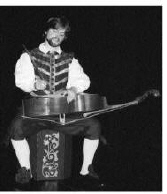 audience.
Even the use of historical instruments such as the viola
da gamba, chitarrone, and lute for the performance of
music by Monteverdi, Caccini, and Purcell up to that of
Michel Pignolet de Monteclair offered great pleasure. But
the framework in which this time-honored music was
presented provided the evening's fascination. In the
footsteps of commedia dell'arte, texts by Molière and
scenes by Shakespeare were performed in conjunction with
song, dance, and fascinating instrumental contributions. audience.
Even the use of historical instruments such as the viola
da gamba, chitarrone, and lute for the performance of
music by Monteverdi, Caccini, and Purcell up to that of
Michel Pignolet de Monteclair offered great pleasure. But
the framework in which this time-honored music was
presented provided the evening's fascination. In the
footsteps of commedia dell'arte, texts by Molière and
scenes by Shakespeare were performed in conjunction with
song, dance, and fascinating instrumental contributions.
Three backdrops
mounted on large frames, opened one after the other, show
the respective scene of action. Custom-made, contemporary
costumes, accurate to the last detail, created the
requisite atmosphere for the four scenes. Already the
first piece, "Ghirlande amorose," put the
audience in a good mood. Shakespeare's A Midsummer Night's
Dream was the background for the second scene, which was
just as successful as the third, based on the theme of
"English humour," with music by Thomas Ford and
Tobias Hume. The playing of the reconciled pair, Captain
Hume and Mrs. Hume, was splendid. The latter had shortly
before shot her rival, namely with a viola da gamba.
Sitting behind her, it soon becomes obvious who calls the
tunes here.
The last scene
is entitled "Fête Champestre." The enchanting
introduction with music by Marais and Monteclair, to which
the shepherdess Lisette plays and dances a sarabande
("Les folies d'Espagne"), is followed by
pitch-black drama. Enthusiastic and well-deserved applause
for the visitors from Basel. |
|
Barbara Percovac |
|
BADISCHE
ZEITUNG 09/1998
„TEATRO
ARCIMBOLDO": The burlesque, turbulent side of the
Baroque |
|
|
That the musical epoch of the Baroque also had a
burlesque, turbulent, entertaining, and theatrically
effective side was shown on Saturday evening in Weil's Old
Town Hall by "TEATRO ARCIMBOLDO," which was
founded in 1996 by Thilo Hirsch.
In the first
scene, "Ghirlande amorose," it quickly became
clear: It did not have to do with deep, existential
feelings. The fundamental attitude was that of light,
playful virtuosity. Fileno disguised himself as Vespone,
became involved in a brilliant vocal duel with Lilla
(Araceli Fernandez), which then - as Fileno revealed his
identity - evolved into an elaborate duet with much
ornamentation. There was not much to the apparently so
deeply felt love, for Fileno willingly lets himself be
ensnared by Colombina (Barbara Leitherer) with song and
dance.
The heart of
the performance was formed by the two scenes, "A
Midsummer Night's Dream" and "English
humour," based on Shakespeare.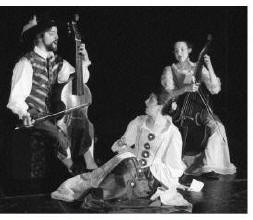 Here, too, turbulent about turns, mirages, and
aberrations: First, a vision, to which Motta provides the
congenial accompaniment with sparkling, meditative runs,
then Hume's real courtship of Molly, who is ultimately
felled by the Captain's wife with a pistol shot. Here the
actors show their extraordinary, versatile abilities most
impressively: While Thilo Hirsch plays a gamba duet with
Barbara Leitherer, he woos the soprano playing the role of
Molly with his song. And after her apparent death, an even
more unusual duet: Hirsch and Leitherer play four-handed
on one gamba.
Here, too, turbulent about turns, mirages, and
aberrations: First, a vision, to which Motta provides the
congenial accompaniment with sparkling, meditative runs,
then Hume's real courtship of Molly, who is ultimately
felled by the Captain's wife with a pistol shot. Here the
actors show their extraordinary, versatile abilities most
impressively: While Thilo Hirsch plays a gamba duet with
Barbara Leitherer, he woos the soprano playing the role of
Molly with his song. And after her apparent death, an even
more unusual duet: Hirsch and Leitherer play four-handed
on one gamba.
Something that
hoped to be successful at princely courts had to include
excursions into all genres: The last scene therefore
combined idyll and horror romantic in the story of the
shepherdess and dancer Lisette (Barbara Leitherer). The
audience honored the performance with enthusiastic
applause. |
|
hf. |
|
Volksstimme
Sissach 06/1998
"TEATRO
ARCIMBOLDO" - high standard |
|
|
On Sunday afternoon in Liestal's "Palazzo,"
the young ensemble "TEATRO ARCIMBOLDO" abducted
its audience into another world for almost two hours.
Music of the Renaissance and early Baroque was offered
under the title "If music be the food of love"
as "Baroque chamber-music dance-theater." A
distinctly original idea by the ensemble's founder and
director Thilo Hirsch.
In four scenes,
the magic of that earlier time unfolded in the unanimity
of representation, song, and music in the gay opalescence
of the costumes. The music of Monteverdi, Caccini,
Purcell, Sances, and others was combined collage-like with
texts by Molière and Shakespeare, and could develop to
best advantage in the play of love's heartache and joy.
Special
attention has to be called to the high artistic standard
of all the ensemble members, beginning with the excellent
gambist and tenor Thilo Hirsch, who masters the
"cantar alla viola," and his partner Araceli
Fernandez, whose clear soprano voice has a rich spectrum
of colors at its disposal, and whose Baroque gestures were
a joy to behold. Amazing were the abilities of Barbara
Leitherer in expressive gamba playing and light-footed
historical dance. Reliably active in the background was
Agileu Motta with sonorous lute and chitarrone. Dancing
and singing, all four also joined together in polyphonic
song.
The whole is an
exquisite treasure, not only for connoisseurs, that
conveys, even into details, a taste of that Baroque joy of
living that can gild everyday life. |
|
E.J. |
| |
|
|